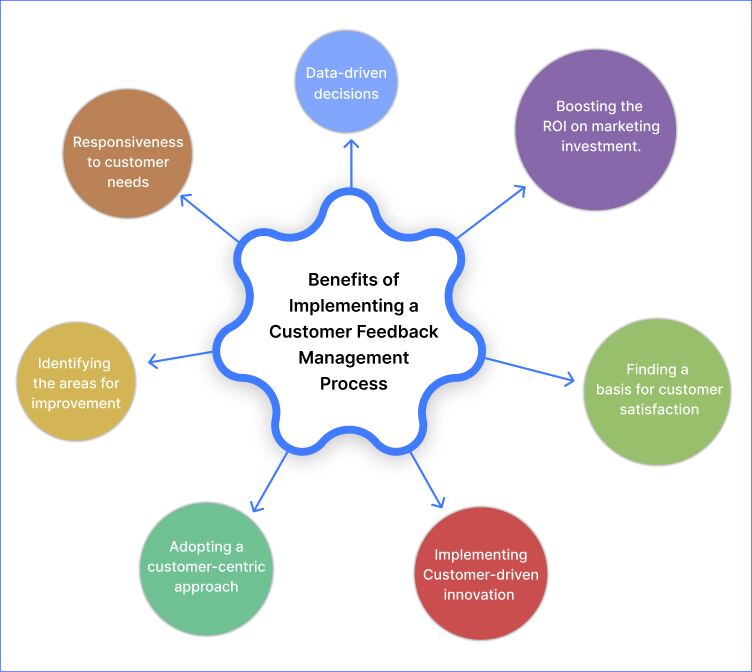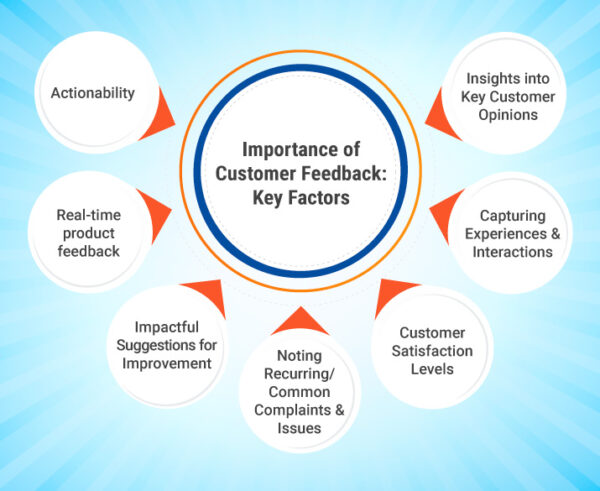Introduction
Overview of Customer Feedback
In today’s fast-paced business environment, customer feedback has emerged as a powerful tool that shapes a company’s direction. Essentially, customer feedback encompasses the opinions, insights, and experiences shared by customers regarding a product or service. It can be collected through various channels, such as:
- Surveys: Quick and structured questions that gauge customer satisfaction.
- Social Media: Comments and reviews shared on platforms like Facebook and Twitter.
- Customer Reviews and Testimonials: Feedback posted on business pages or third-party review sites.
This feedback serves as a valuable compass for businesses aiming to align their offerings with customer needs.
Significance of Customer Feedback for Businesses
Understanding the importance of customer feedback goes beyond mere appreciation; it acts as a lifeline for businesses seeking to thrive. For instance, a company may think that their product is perfect, but customer insights might reveal minor tweaks that could enhance performance or usability. Here are a few reasons why customer feedback is significant:
- Guides Product Development: Companies can prioritize enhancements based on actual user experiences.
- Builds Customer Relationships: Acknowledging feedback fosters trust and communication between the business and its customers.
- Supports Competitive Advantage: Businesses that leverage customer feedback often outperform their competitors by staying ahead of market trends.
In summary, customer feedback is not just a box to tick; it is essential for achieving sustained growth and customer loyalty. By actively engaging with customer opinions, companies can navigate challenges and seize growth opportunities more effectively.

Benefits of Customer Feedback
Improving Products and Services
One of the most significant benefits of customer feedback is its ability to drive improvements in products and services. When customers express their thoughts, they often highlight specific features that could be enhanced or issues that need to be addressed. For example, a tech company might receive feedback that their app crashes frequently during updates. Addressing such issues not only improves the app but also shows customers that their input is valued.
Enhancing Customer Satisfaction
Customer satisfaction is crucial for business success, and feedback helps achieve just that. Listening to customers and implementing their suggestions can lead to a more tailored experience. Consider a restaurant that alters its menu based on customer preferences. By incorporating popular dishes and removing less favored ones, they enhance overall satisfaction and create a memorable dining experience. Key points to remember about customer satisfaction:
- Direct Communication: Customers appreciate when their feedback leads to tangible changes.
- Sense of Involvement: When customers see their opinions reflected in services, they feel more connected.
Building Customer Loyalty
Customer loyalty often follows suit when positive experiences are created through feedback. Return visits and recommendations flourish when customers feel their voices are heard. For instance, a clothing brand that frequently engages with its audience about design choices is likely to build a loyal customer base eager to support their evolving styles.
Identifying Areas for Growth
Moreover, customer feedback can illuminate areas for growth that might not be obvious from internal analysis. Through feedback, businesses can uncover emerging trends or gaps in the market. For instance, if multiple customers express interest in sustainable options, a company can pivot towards eco-friendly products, tapping into a lucrative market segment. In summary, embracing customer feedback is instrumental for businesses looking to improve, satisfy, and retain their customer base while exploring new growth avenues.

Methods of Collecting Customer Feedback
Surveys and Questionnaires
Now that we understand the numerous benefits of customer feedback, let's dive into effective methods for collecting it. One of the most traditional yet effective ways is through surveys and questionnaires. They provide structured avenues for customers to express their opinions. For example, a company might send out a short survey after a purchase, asking customers to rate their shopping experience. The responses can pinpoint areas that require improvement, like delivery times or product quality.
- Types of Surveys:
- Post-Purchase Surveys: Gauge customer satisfaction immediately after a purchase.
- Net Promoter Score (NPS): Measure customer loyalty and likelihood to recommend.
Social Media Listening
Another powerful method is social media listening. This involves monitoring social platforms for mentions of your brand or products. Customers often share their experiences—both good and bad—on social media, making it a treasure trove of insights. For example, if a customer tweets about a frustrating experience with a product, the company can respond quickly, showing that they care about customer concerns.
- Benefits of Social Media Listening:
- Real-time Feedback: Gather insights as they occur.
- Broader Reach: Gain feedback from a wide audience without solicitation.
Customer Reviews and Testimonials
Customer reviews and testimonials provide another important feedback channel. These can be found on company websites, third-party review sites, or even Google. Positive reviews can improve brand credibility, while constructive criticism can offer a clear roadmap for enhancements. For instance, a hotel can adjust its services based on feedback about cleanliness or amenities mentioned in reviews.
Feedback Forms
Lastly, feedback forms are direct and simple tools for collecting customer opinions. These forms can be integrated into websites, emails, or even physical receipts. They allow customers to share their thoughts in more detail without feeling rushed. An example could be a restaurant providing a feedback form with the check, prompting diners to share their thoughts on the meal and service. In essence, combining these diverse methods allows businesses to gather a comprehensive view of customer opinions, ultimately leading to better decision-making and enhanced experiences.

Analyzing and Implementing Customer Feedback
Data Analysis and Interpretation
With various methods of collecting customer feedback in place, the next critical step is analyzing and interpreting this valuable data. It’s essential to translate raw feedback into actionable insights. For example, imagine a software company that gathers thousands of user reviews. They can employ data analysis techniques to identify common themes, such as recurring issues with a specific feature.
- Key Steps in Data Analysis:
- Data Cleaning: Eliminate duplicates and misleading entries to ensure accurate analysis.
- Qualitative Analysis: Categorize feedback into themes to identify patterns.
- Quantitative Metrics: Use metrics, like response rates or NPS scores, to measure satisfaction levels effectively.
By carefully sifting through the data, businesses can pinpoint critical areas requiring attention or improvement.
Incorporating Feedback into Business Strategies
Once the feedback has been analyzed, it’s time to incorporate it into business strategies. This process bridges the gap between customer insights and real-world changes. For instance, if customer feedback reveals dissatisfaction with product usability, the product development team can prioritize redesigning the interface.
- Strategies for Incorporation:
- Set Actionable Goals: Define clear objectives based on feedback, such as reducing complaints about a specific service by a set percentage.
- Cross-Department Collaboration: Engage various departments—like marketing, sales, and customer support—in discussions on how to best implement changes based on feedback.
- Monitor Changes: Regularly review performance metrics post-implementation to assess the effectiveness of the alterations made.
An example of successful implementation might be a retail company that accelerates its checkout process based on feedback, resulting in a more efficient shopping experience. This kind of responsiveness not only enhances customer satisfaction but also fosters stronger loyalty. By dedicating time to analyze and implement customer feedback effectively, businesses can remain relevant and competitive in an ever-evolving marketplace.

Responding to Customer Feedback
Acknowledging Feedback
Having effectively analyzed and incorporated customer feedback, the next crucial step is to respond to it. Acknowledgment is the foundation of a positive customer relationship. When customers take the time to share their thoughts, they want to feel heard. Simple gestures, such as responding to reviews or thanking customers for their feedback, can make a significant difference. For instance, a local coffee shop might write personalized notes on social media thanking customers who suggested new drink ideas.
- Best Practices for Acknowledgment:
- Timely Responses: Aim to respond as quickly as possible—ideally within 24 hours.
- Personalization: Tailor responses to show that you value individual experiences.
Addressing Customer Concerns
Once feedback has been acknowledged, it's vital to address any concerns raised directly. This not only resolves issues but also demonstrates commitment to customer satisfaction. For example, if a customer mentions that their order was delayed, a quick response offering an apology and a discount for their next purchase can turn a negative experience into a positive one.
- Steps to Address Concerns:
- Investigate the Issue: Understand the root cause of the problem before responding.
- Offer Solutions: Provide clear remedies, such as refunds, replacements, or discounts.
- Maintain a Positive Tone: Keep communications upbeat and reassuring.
Implementing Changes Based on Feedback
Finally, the most impactful aspect of responding to feedback is implementing changes. When customers see that their suggestions lead to real improvements, it strengthens their trust in the brand. For instance, if multiple customers express the need for faster service at a restaurant, the management can rearrange staff schedules or streamline processes during peak hours.
- Implementation Strategies:
- Communicate Changes: Inform customers about the adjustments made based on their input.
- Monitor Results: After implementing changes, continue to gather feedback to assess effectiveness.
- Celebrate Successes: Share success stories on social media, showcasing how customer input shaped improvements.
By actively responding to customer feedback through acknowledgment, addressing concerns, and implementing changes, businesses can build lasting relationships that foster loyalty and growth. When customers feel valued, they are more likely to return and advocate for the business within their networks.
Monitoring and Measuring Feedback Effectiveness
Setting Key Performance Indicators (KPIs)
As businesses respond to customer feedback and implement changes, it's essential to monitor and measure the effectiveness of these initiatives. This is where Key Performance Indicators (KPIs) come into play. KPIs are quantifiable metrics that help businesses assess their progress and success in various areas, particularly regarding customer satisfaction and loyalty. When setting KPIs, consider specific, measurable aspects of customer feedback:
- Customer Satisfaction Score (CSAT): Measures client satisfaction with a product or service.
- Net Promoter Score (NPS): Gauges customer loyalty and willingness to recommend the business to others.
- Customer Retention Rate: Tracks the percentage of customers who continue to do business over a certain period.
For instance, a travel agency might set a KPI to increase its NPS by 15% in the upcoming year after implementing several customer-driven improvements. By defining these metrics, businesses can focus their efforts on what matters most to their customers.
Tracking Feedback Impact on Business Growth
Once KPIs are established, the next step is tracking their impact on overall business growth. This involves analyzing trends over time to determine whether customer feedback leads to tangible improvements. For example, if a retail store introduced a streamlined checkout process based on customer comments, monitoring the average transaction time and customer complaints can indicate whether this change succeeded.
- Effective Tracking Methods:
- Data Analytics: Use tools to analyze sales figures and customer satisfaction metrics simultaneously.
- Customer Surveys: Regularly distribute surveys to measure ongoing satisfaction levels.
- Feedback Loops: Create systems for customers to continue providing feedback on implemented changes.
By consistently tracking the influence of feedback on KPIs, businesses can gain insightful data to adapt their strategies further. A tech company may notice increased customer retention correlated with enhancements made based on previous feedback, underscoring the importance of responsiveness. In summary, setting KPIs and tracking impacts not only validates the changes made but also reinforces a culture of continuous improvement—ensuring that customer feedback remains central to business strategies.
Case Studies: Successful Implementation of Customer Feedback in Oman
Company A: Using Feedback to Launch New Products
In Oman, one remarkable example of leveraging customer feedback is Company A, a local cosmetics brand. Faced with increasing competition, Company A decided to actively solicit input from its clients through surveys and focus groups. They wanted to understand what types of products customers were interested in. The feedback revealed a strong demand for natural, eco-friendly beauty solutions. In response, Company A launched a new line of organic skincare products that addressed specific customer needs, such as hypoallergenic formulations and sustainable packaging.
- Results:
- Increased Sales: The new product line exceeded sales expectations by 30% in its first quarter.
- Customer Engagement: Social media interactions skyrocketed as customers shared their experiences with the new products, enhancing brand visibility.
Through this strategic move, Company A not only tapped into a growing market but also demonstrated that listening to customer feedback can directly lead to successful product development.
Company B: Improving Customer Service Through Feedback
Another outstanding example is Company B, a well-known restaurant chain in Oman. Facing declining customer satisfaction ratings, the management decided to utilize feedback forms to identify specific service issues. Through gathered feedback, they learned that diners often experienced long wait times, particularly during peak hours. In response, the management implemented a new reservation system and adjusted staffing schedules to ensure adequate coverage during busy periods.
- Key Changes:
- Improved Training: Staff received customer service training focused on efficiency and attentiveness.
- Real-time Feedback: The restaurant introduced digital feedback tablets at each table, allowing customers to provide immediate input.
As a result, Company B experienced a notable uptick in customer satisfaction scores and positive online reviews. Customers appreciated the quicker service and felt more valued, ultimately leading to a 20% increase in repeat visits. In summary, both Company A and Company B exemplify how effectively implementing customer feedback can lead to significant enhancements in product offerings and service quality. Their success stories illustrate the power of listening to customers and adapting to their needs in the competitive Omani market.

Challenges in Utilizing Customer Feedback
Handling Negative Feedback
While customer feedback can be a boon for any business, it also presents several challenges, one of the most significant being how to handle negative feedback. Encountering criticism can be tough; however, it's crucial to view it as an opportunity for growth rather than a setback. For instance, a small bakery may receive a negative review about a stale pastry. Instead of reacting defensively, they could acknowledge the mistake and offer a replacement—or even a discount on a future purchase.
- Strategies for Handling Negative Feedback:
- Timely Responses: React promptly to show customers their voices matter.
- Empathy: Acknowledge the customer's feelings to validate their experience.
- Constructive Action: Use the feedback to enhance products or services.
Dealing with Inaccurate or Biased Feedback
Another challenge arises when facing inaccurate or biased feedback. Sometimes, customers may have unreasonable expectations or may not have all the facts. For example, if a client complains about delays in service without considering external factors like a supply chain disruption, it's essential to address these misconceptions directly.
- Approaches to Manage Inaccurate Feedback:
- Clear Communication: Explain the situation calmly and provide context.
- Encourage Dialogue: Invite the customer to share more details, allowing for clarification.
- Focus on Facts: Use data to back up your responses where appropriate.
Ensuring Feedback Integration Across Departments
Finally, ensuring that feedback is integrated across departments can pose a significant challenge. Often, insights gathered by customer service might not reach product development or marketing teams, leading to missed opportunities. For instance, if customer service notes frequent requests for a certain feature but the product team isn't aware, those customer needs remain unmet.
- Solutions for Integration:
- Centralized Feedback Systems: Use software that collects and shares feedback across departments.
- Regular Meetings: Host cross-departmental meetings to encourage the sharing of insights.
- Culture of Collaboration: Foster an organizational culture that values customer input across all levels.
In conclusion, while there are challenges in utilizing customer feedback, businesses can navigate these hurdles through effective communication and cross-departmental collaboration. By embracing negative feedback, addressing inaccuracies, and ensuring that insights reach all relevant parts of the organization, businesses can continuously improve and align more closely with customer expectations.
Future Trends in Customer Feedback Strategies
Leveraging Artificial Intelligence for Feedback Analysis
As we look towards the future, one of the most exciting trends in customer feedback strategies is the integration of Artificial Intelligence (AI) for feedback analysis. AI technology can rapidly process large volumes of customer data, identifying patterns and sentiments far beyond what manual methods can achieve. For instance, a telecommunications company might use AI to scan thousands of customer reviews to detect common issues, allowing for quicker responses and more targeted improvements.
- Benefits of AI in Feedback Analysis:
- Speed: AI can analyze feedback in real-time, enabling prompt decision-making.
- Accuracy: Machine learning algorithms can detect nuances in language, spotting trends more accurately.
- Predictive Insights: AI can forecast future customer needs based on historical data trends.
Personalizing Customer Feedback Experiences
Another future trend is the personalization of the customer feedback experience. Customers today expect tailored interactions, and feedback collection methods are no exception. For example, businesses could personalize surveys by suggesting questions based on previous purchases or interactions, making consumers feel more valued.
- Strategies for Personalization:
- Segmented Surveys: Divide customers into groups and tailor questions to their specific behaviors.
- Customized Follow-ups: Send personalized thank-you messages or updates based on the feedback provided.
- AI-Powered Recommendations: Use algorithms to suggest products or services based on feedback.
The Role of Feedback in Shaping Business Evolution
Finally, the role of feedback in shaping business evolution is becoming increasingly pronounced. Companies that actively solicit and act on feedback are more likely to stay relevant in fast-changing markets. Rather than viewing feedback as a static end-point, businesses should see it as a dynamic tool for continuous improvement.
- Integrating Feedback into Business Strategy:
- Agile Development: Implement an iterative approach where products evolve based on ongoing customer input.
- Cultural Emphasis: Foster a culture that values customer input at all levels, making it a core part of strategic planning.
In conclusion, the future of customer feedback strategies is bright with possibilities, thanks to advancements in AI, personalized experiences, and a commitment to integrating feedback into business evolution. By staying ahead of these trends, companies can create strong customer connections and adapt more swiftly to their evolving needs.

Conclusion
Recap of the Importance of Customer Feedback
As we conclude our exploration of customer feedback strategies, it's essential to recognize just how pivotal customer feedback is for businesses today. It serves as a guiding force, illuminating the path toward improved products, heightened customer satisfaction, and ultimately, increased loyalty and growth. Throughout the article, we’ve seen how organizations leverage customer insights to refine their offerings, tackle challenges, and adapt to changing market dynamics.
- Key Takeaways:
- Understanding Needs: Customer feedback provides direct insights into customer preferences and needs.
- Driving Innovation: Innovative ideas often stem from listening to the voice of the customer.
- Strengthening Relationships: Acknowledging and responding to feedback enhances trust and rapport with clients.
Final Thoughts on Leveraging Feedback for Business Growth
In this fast-paced business environment, companies that prioritize customer feedback will have a competitive edge. By creating systems that not only collect but also analyze and act upon feedback, businesses can ensure that they remain relevant and responsive to customer demands. As future trends such as AI-driven analytics and personalized feedback experiences shape how we approach customer interactions, companies must be proactive in adapting these strategies. Remember, customer feedback should not merely be a checkbox in the business process; it deserves to be embedded in the corporate culture. Embracing a comprehensive approach to feedback—recognizing its potential to drive meaningful change—will position businesses for sustained success. By valuing customer insights as the cornerstone of strategy and innovation, organizations can enhance their growth trajectory and foster a loyal customer base. In the end, it’s about creating a continuous dialogue that leads to lasting relationships and mutual success.



0 Comments